Handley Page Halifax - 1/72 Matchbox
Discussion
As usual, because of work pressure, my model building takes a serious back seat for the months of October through to the end of January. This year has been no different. One of the things that keeps me going through the "bleak midwinter" is the knowledge that from February, my time is a lot less constrained and I can start thinking about what models I want to build for the next few months.
I've been building up in my stash a collection of various Halifax kits and I thought it must be about time that I actually assembled one of them. The one I have chosen to build is the venerable Matchbox kit which was originally issued back in 1979. It was later released under the Revell label. This could be a bit confusing for some modellers because in the last few years Revell has also released two brand new Halifax kits which are pretty much state of the art as far as quality of moulding, panel lines etc are concerned. Despite this, the first Revell issue, which was of the early Merlin powered versions, has some serious shape and dimension issues, particularly around the size of the engines , propellers and main wheels - which is a real pity. Their second new tool release which features the later Hercules powered versions is better (although the undersized mainwheels are still included).
The Matchbox kit has a few issues of its own. It's obviously an older technology kit and is less complex with less detail. There is also a problem in that the nose is a bit too long.
However, its main issue is the shape of the cockpit transparencies. The Halifax had an asymmetric shape to the canopy, the front windscreen on the starboard side being deeper than on the port. This was to give the pilot a better view off to his right. Matchbox missed this completely when they moulded the canopy. I have a Falcon "RAF Bomber" set which contains correct shape canopies so hopefully I can replace the kit version with the Falcon one - although some surgery to the kit is required to make it fit. As far as I know, they got the engine nacelles, wheels and propellers correct.
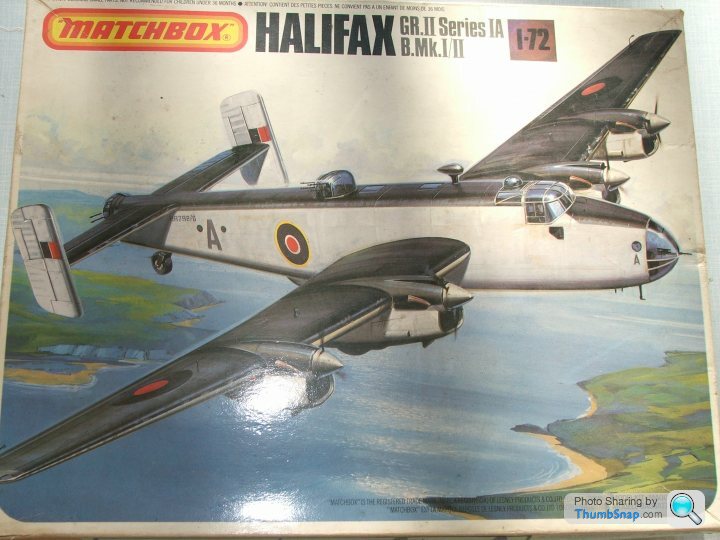
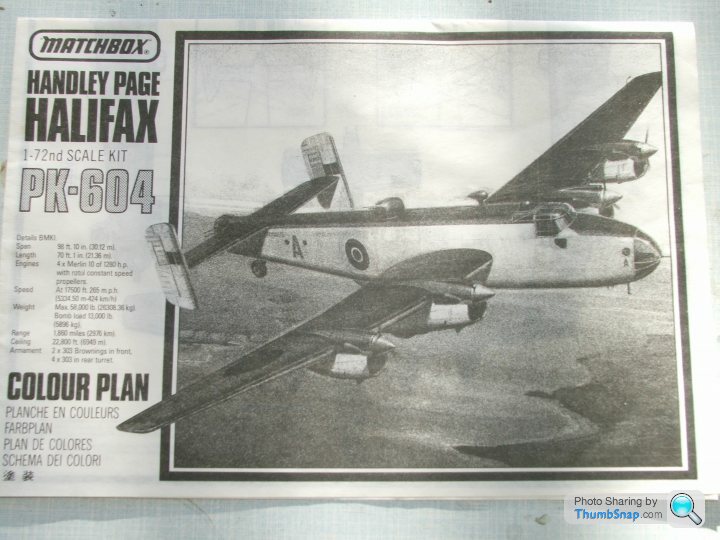

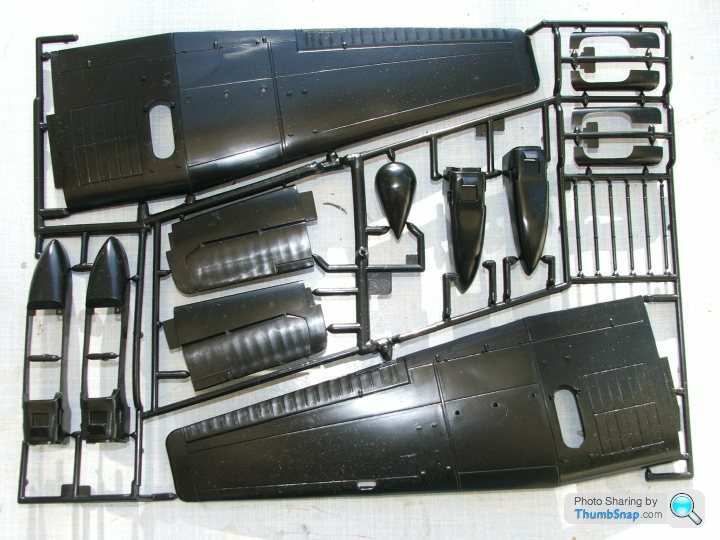
I've been building up in my stash a collection of various Halifax kits and I thought it must be about time that I actually assembled one of them. The one I have chosen to build is the venerable Matchbox kit which was originally issued back in 1979. It was later released under the Revell label. This could be a bit confusing for some modellers because in the last few years Revell has also released two brand new Halifax kits which are pretty much state of the art as far as quality of moulding, panel lines etc are concerned. Despite this, the first Revell issue, which was of the early Merlin powered versions, has some serious shape and dimension issues, particularly around the size of the engines , propellers and main wheels - which is a real pity. Their second new tool release which features the later Hercules powered versions is better (although the undersized mainwheels are still included).
The Matchbox kit has a few issues of its own. It's obviously an older technology kit and is less complex with less detail. There is also a problem in that the nose is a bit too long.
However, its main issue is the shape of the cockpit transparencies. The Halifax had an asymmetric shape to the canopy, the front windscreen on the starboard side being deeper than on the port. This was to give the pilot a better view off to his right. Matchbox missed this completely when they moulded the canopy. I have a Falcon "RAF Bomber" set which contains correct shape canopies so hopefully I can replace the kit version with the Falcon one - although some surgery to the kit is required to make it fit. As far as I know, they got the engine nacelles, wheels and propellers correct.




Eric Mc said:
However, its main issue is the shape of the cockpit transparencies. The Halifax had an asymmetric shape to the canopy, the front windscreen on the starboard side being deeper than on the port. This was to give the pilot a better view off to his right. Matchbox missed this completely when they moulded the canopy.
It looks to me that from the sprues you posted that the canopy opening is deeper on the stbd. side. My own Matchbox Halifax is long gone, but from the pictures I can find online, the cockpit opening and canopy look fine to me (considering the age and relative simplicity of the kit). Are you saying the transparency itself is wrong? I don't remember it having a large gap on one side.
lufbramatt said:
I think Eric is correct- the whole starboard side of the top of the nose slopes away on the full size Halifax, making the screen dip down further on that side. I can't see this on built on Matchbox Halifax models.
I think the canopy side is lower on the right, so at some point the windscreen must arc down to match it, but maybe it's not as pronounced on the Matchbox kit. Still, I wouldn't want to cut and shut a vacform canopy onto it, it'll probably look worse than the original all things considered.Yes the canopy side window is lower on the kit, the issue is the shape of the front windscreen panel. The bottom edge should slope down diagonally from the centreline rather than having a rounded top to the nose. So the issue isn't so much the shape of the canopy but the profile of the top of the nose.
http://3ukr694671p02fhcme3a1bsaiek.wpengine.netdna...
http://3ukr694671p02fhcme3a1bsaiek.wpengine.netdna...
Five years on and I am finally having a second look at this project. Sadly, my initial look coincided with my wife being gravely ill and consequently, it was put aside whist much more important things needed to be dealt with.
However, I still want a Halifax in my collection so time to give it another go.
However, I still want a Halifax in my collection so time to give it another go.
Super Sonic said:
Sorry to hear about your wife, hope she's feeling better.
Sadly, Hazel passed away not long after I made that original post back in January 2019. Which is why I didn't go back to the project for such a long time.Life has moved on a lot since then and is actually pretty good now - although memories of that period are still very sad.
Fuselage together now. Lots of filler required - chiefly because Matchbox provided alternative noses and as a result the fuselage is cut just forward of the cockpit to allow for the nose choice. As a result, the fit isn't that great.
However, now that the fuselage is together, it's beginning to look like a Halifax.
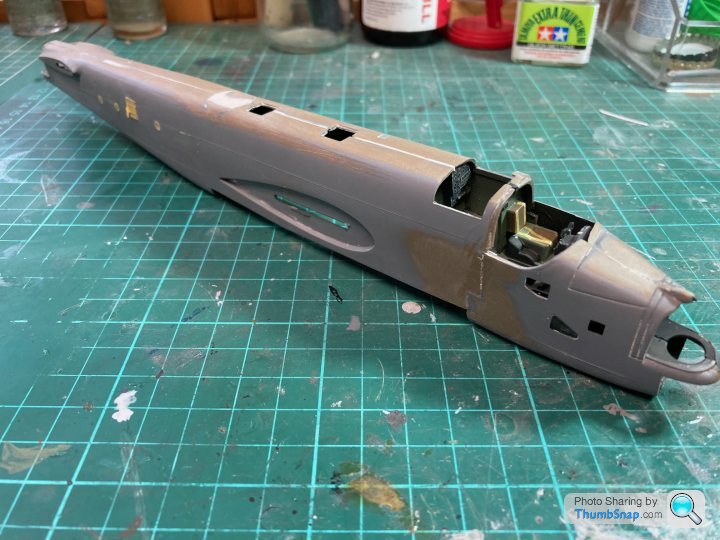
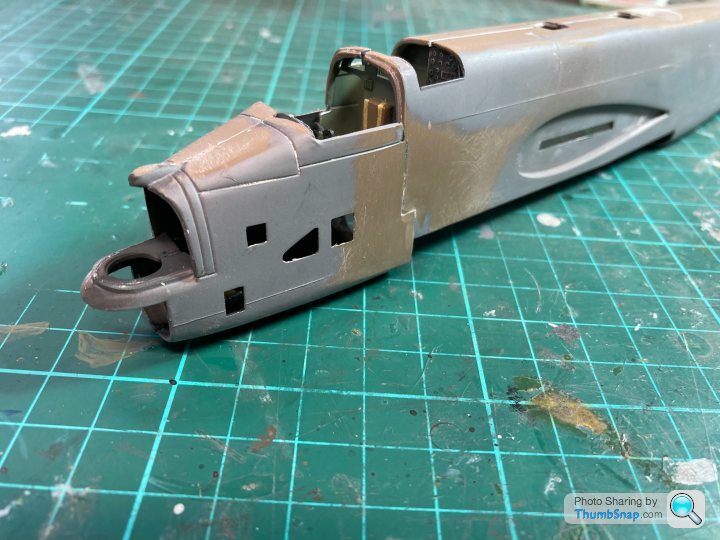
However, now that the fuselage is together, it's beginning to look like a Halifax.


After a bit of a gap because of other commitments, I made it back to my workbench last night and spent most of the evening working on the engine nacelles. Because Matchbox allowed you to build two quite distinct variants of the Halifax, they supplied various permutations on the engine nacelles, such as different exhausts and different air intakes.
Some cleaning up and filler will be required.

Some cleaning up and filler will be required.
I always liked the Halifax as I feel its reputation is that of an underdog - which it wasn't really. The early ones were a bit iffy I have to admit but the later Hercules powered versions were very good aeroplanes - and better in some respects than the Lancaster.
The Matchbox kit is actually quite pleasant to build. I think that it could even have been better if they hadn't tried to shoehorn in two distinct and different versions. That resulted in a few too many parts compromises with resultant fit issues.
I spent an hour last night applying some filler to the gaps in the engine nacelles. Once that has dried and been sanded, I'll fit the engines to the wing - and I can already see that this will require more filling and sanding as there are noticeable gaps where the nacelles meet the underside of the wing.
Top
The Matchbox kit is actually quite pleasant to build. I think that it could even have been better if they hadn't tried to shoehorn in two distinct and different versions. That resulted in a few too many parts compromises with resultant fit issues.
I spent an hour last night applying some filler to the gaps in the engine nacelles. Once that has dried and been sanded, I'll fit the engines to the wing - and I can already see that this will require more filling and sanding as there are noticeable gaps where the nacelles meet the underside of the wing.
Top
Eric Mc said:
I always liked the Halifax as I feel its reputation is that of an underdog - which it wasn't really. The early ones were a bit iffy I have to admit but the later Hercules powered versions were very good aeroplanes - and better in some respects than the Lancaster.
I was surprised to read recently that many Halifax crews were disappointed to convert to Lancasters, the Halifax being considered more of a "gentleman's aircraft" and also having better/bigger hatches for emergency departure. I guess Harris preferred the Lancaster because it could carry more bombs.Yep - as a pure heavy bomber the Lancaster was probably the best. But it did have some shortcomings - especially regarding the comfort and safety of the crews. Harris was less interested in that compared to his desire to drop as much tonnage of bombs on Germany as he possibly could. For that purpose nothing could touch a Lanc.
In some theatres, especially hotter climates, the Hercules powered Halifaxes were better performers.
There is no doubt that the original Merlin powered Halifaxes left a lot to be desired. They were a bit underpowered but more importantly, had some serious aerodynamic issues. The engine nacelles created a huge amount of drag and the original small fin and rudder set up meant control could easily be lost in extreme manoeuvering.
The fitting of the Hercules sorted out the power and nacelle drag problems and the new larger fin and rudders sorted the "rudder hard over" issues.
There was also a general clean up of the fuselage profile as the original had lots of lumps, bumps and other protruberances which didn't do much to reduce drag.
In some theatres, especially hotter climates, the Hercules powered Halifaxes were better performers.
There is no doubt that the original Merlin powered Halifaxes left a lot to be desired. They were a bit underpowered but more importantly, had some serious aerodynamic issues. The engine nacelles created a huge amount of drag and the original small fin and rudder set up meant control could easily be lost in extreme manoeuvering.
The fitting of the Hercules sorted out the power and nacelle drag problems and the new larger fin and rudders sorted the "rudder hard over" issues.
There was also a general clean up of the fuselage profile as the original had lots of lumps, bumps and other protruberances which didn't do much to reduce drag.
Eric Mc said:
I think that it could even have been better if they hadn't tried to shoehorn in two distinct and different versions. That resulted in a few too many parts compromises with resultant fit issues.
They didn't have much choice.If you look at, for example, their Lancaster, Privateer or B-17 sprues, the nose (and sometimes tail) halves are separate despite there being no alternative version options. This is because Matchbox were limited to the size of moulds they could produce, and often had to split the longer parts of their models (e.g. bomber fuselages) into sections such that they would fit within that limited area, while limiting themselves to the number of sprues per box.
Gassing Station | Scale Models | Top of Page | What's New | My Stuff




